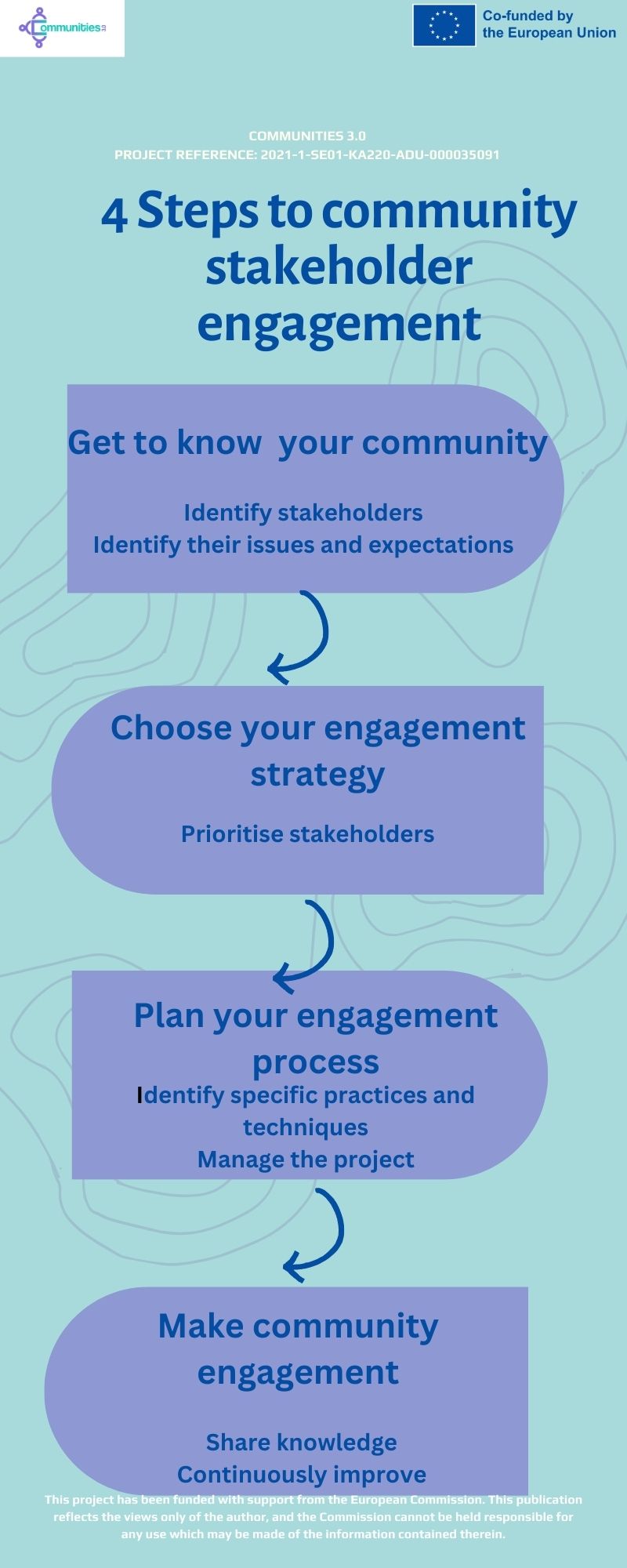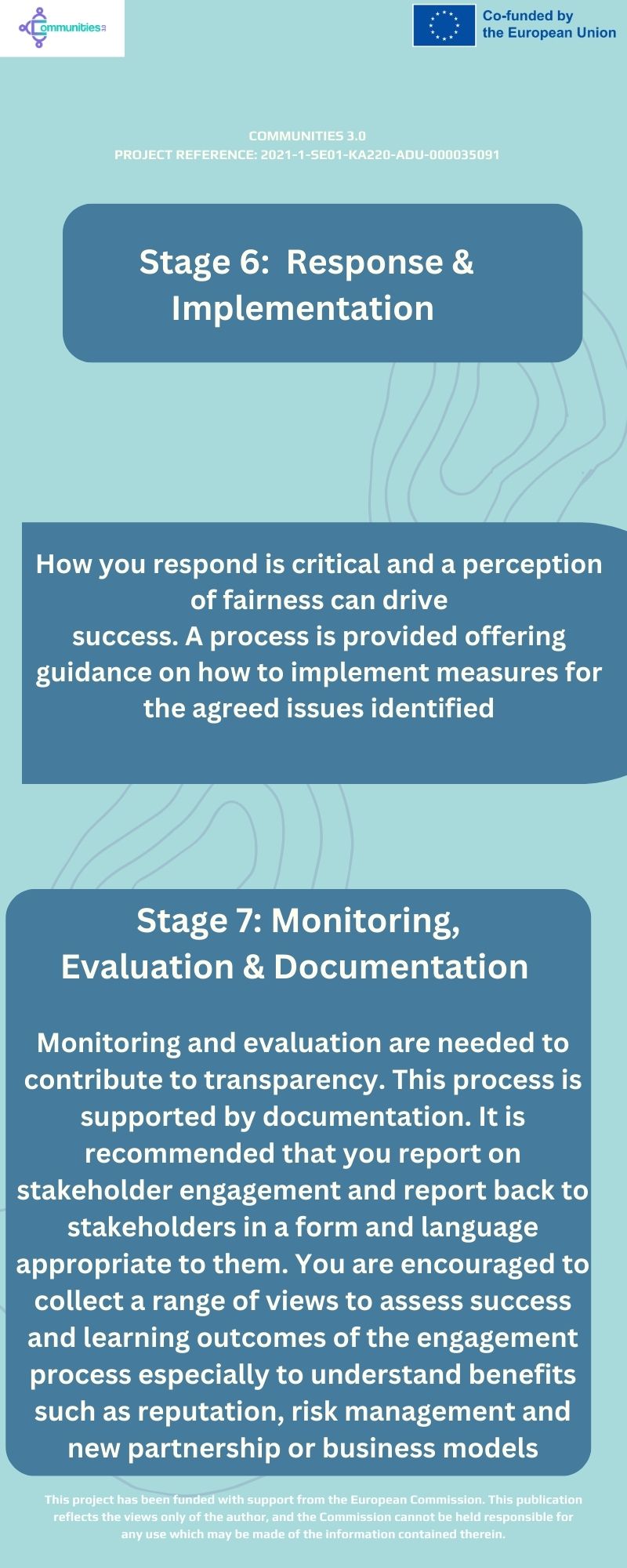The learning objective of this chapter is to understand the significance of stakeholders in relation to the communities trainees participating in the Communities 3.0 programme belong to and how they can reach out to their own stakeholders to build partnerships or strengthen already existing partnerships and collaborations.
By the end of this chapter, each participant will be able to:
a) identify who a stakeholder is, understand their function in the community and why stakeholder engagement is important
b) build a partnership, consortium, or association
c) come up with a stakeholders’ engagement strategy and supporting activities that will ensure the reach of the strategy and its impact
This section provides both the theoretical backgrounds and hands-on activities and tools for participants to be able to apply in their own work. Concepts that will be addressed below include the definition of stakeholders, stakeholder analysis and engagement which include mapping and stakeholder analysis. In the following, topics such as stakeholder mapping and engagement and how to categorize stakeholders into primary stakeholders (directly interested in the project’s activities) and secondary stakeholders (indirectly affected) will be addressed.
The stakeholder analysis identifies, categorizes and prioritizes stakeholders from the adult education and training sector; national, regional and local authorities, civil society organizations and other professional associations. In the scope of the project, the provided definitions and information will be targeted to individuals who are managers and educators at civil society organisations and adult education providers working with social inclusion and/or active citizenship and civic engagement in SEDN.
The information provided is both theoretical, so that participants can understand the context and the significance of the discussed topic, and practical so that they can understand how to apply these concepts in their communities and line of work.
In the first section, the addressed topics provide the main definitions used to discuss external stakeholders in a general context and most specifically in relation to adult education and civil society organisations and the relations with communities. The definitions and main information are presented in infographics for a higher level of engagement. After that topics where the significance of stakeholders’ participation and involvement with organisations and with communities is analyzed. In addition, there is a step-by-step guide to a stakeholders’ engagement process. The last section provides an overview of stakeholder analysis and communication and transparency towards stakeholders.
Stakeholders: definition, types and examples

Stakeholders are individuals, groups or any party
A stakeholder has an interest in a company and can influence or be influenced by its operations and performance.
Investors, employees, customers, suppliers, communities, governments, and trade associations are typical stakeholders.
Stakeholders of an entity may be either internal or external to the organization.
Shareholders are only one form of stakeholder that organisations must consider.
In some instances, the public may also be considered a stakeholder.
What are the functions of a stakeholder?
In order to prevent their investments from being wasted, stakeholders keep an eye on the development of business ventures.
Using a stakeholder's resources, for instance, a company could construct a new location in a different neighborhood of the city.
The stakeholder's job is to keep track of the new location's progress and put pressure on the company to move forward.
Business managers are aware that they risk losing their funding if they do not finish the project on schedule or according to the contract.

What stakeholders do for communities?

Decision-making: an organization better understands the community’s views and concerns, by incorporating those into project design can lead to more innovative projects.
Legitimacy: when the community stakeholders feel they have been heard, the organization's credibility is enhanced.
Conflict resolution: stakeholders might need to step in and resolve an issue before it escalates, and be prepared to act as mediators.
Competitiveness: improves the quality of products and in turn attracts new employees.
Communities as individuals linked by

Why is it important to cooperate?
In the case of socioeconomically disadvantaged communities, inclusivity is an important aspect.
Before we move into the stakeholder engagement methods, it should be clear why it is important to work with stakeholders.
- Stakeholders can include different agencies and levels of government, civil society and private sector organisations and members of the public.
- Marginalized individuals or groups are those who have limited or no control over the decision-making process and are often overlooked, misrepresented, or inadequately represented. Some examples of marginalized communities are women, indigenous peoples, and local communities. Factors that contribute to marginalization may include gender, ethnicity, socioeconomic status, distance, lack of accessibility, political affiliations, cultural background, and religion.
The four steps to community stakeholder engagement include
- dentification of stakeholders
- prioritization the stakeholders
- identification of specific practices and techniques
- engagement with communities

Strategic approach to stakeholders’ engagement and supporting activities
The objective of this section is to map stakeholders to be targeted by the engagement activities. By mapping and exploring the stakeholders and their individual interests, needs, stakes, barriers, etc. we will be able to carefully target our communications and ensure their engagement and participation in our activities, training and programs.



During the first stage of planning, objectives and the prioritized stakeholders are critical.
The second stage of understanding is important to stress the importance of urgency and interests, as well as the power of stakeholders.
Internal preparation and alignment are needed to dedicate adequate time and resources to identify potential areas of agreement and shared interests.
The levels of trust and willingness to trust vary among different stakeholders thus should be adapted accordingly.
During the fifth stage of consultations, it is important to ensure that all stakeholders are fairly represented. The consultation process should be material to your organisation’s key economic, social and environmental risks. The process of response and implementation offers guidance on how to implement measures for the agreed issues identified. In the final stage of monitoring, evaluation & documentation is encouraged a collection of views for an assessment of learning outcomes of the engagement process.
Engagement Techniques
Information and communication (Investment)
- Provide clear and accessible information using language appropriate for local context and communities
- Explain any uncertainties and limits of the project and be open to feedback
Brochures & flyers, Advertisements, Information Kiosks, Press releases, Newsletters, Door-to-door Information Sessions, Financial Support.
Involvement
- Set up forums for views expressions
- Create informal spaces where you can discuss with stakeholders their views on your project and activities and their concerns
- Organize a facilitated discussion where you provide guidance and create a creative and comfortable environment
Surveys, Studies, Interviews, Consultative committee, Interactive website, Public hearings, Neutral forums.
Integration
- Develop routines that engage the community (e.g monthly or regular meetups) in your planning
- Make sure your staff is familiar with these routines
- Integrate solutions/feedback proposed by your stakeholders in your decisions or in your decision-making processes
Joint project management, Strategic local or regional partnerships, Sector discussion groups, Joint brainstorming, Conflict resolution, Work groups.
The goal of stakeholder analysis is to develop a strategic view of the human and institutional landscape, the relationships between the stakeholders and the issues they care about.
Primary stakeholders are the ones who receive the most impact from projects. These can include employees, customers, managers, suppliers, business partners, etc.
Secondary stakeholders are individuals and groups that are not directly affected. It is more difficult to be identified compared to primary stakeholders. Secondary stakeholders do not normally affect project implementation unless they actively become vocal about their positions.

The goal of stakeholder analysis is to develop a strategic view of the human and institutional landscape, the relationships between the stakeholders and the issues they care about.
Communication and transparency towards stakeholders

A meaningful stakeholder engagement should be a two-way engagement. Good faith and responsiveness are essential factors. These factors can contribute to good communication and transparency. A two-way conversation involves exchange of opinions, perspectives with the aim of achieving mutual understanding.
Strategic approach to stakeholders’ engagement and supporting activities

The significance of having an engagement strategy is to be able to initiate and sustain constructive stakeholder relations and to reach your intended target groups.
To use and apply all the definitions and information provided to each individual of organisations for adult education, civil society organisations and any other group or person engaged and working with communities, especially SEDN should adapt the provided models and information to their own organisations’ context as well as to their local and national context.
Recommendations:
Recommendation for an article https://articulous.com.au/community-stakeholder-engagement/ Community engagement versus stakeholder engagement
https://issuu.com/gsapp_digitalpublishing/docs/case_study_project_book_community_engagement_semin Practice of Community Engagement Case Study Projects
Recommendation for additional materials: https://www.youtube.com/watch?v=goy57PlHTxQ What is a stakeholder engagement and why is it important?
Stakeholder analysis - https://www.youtube.com/watch?v=gY8KxMrMNzk
OECD Due Diligence Guidance for Meaningful Stakeholder Engagement in the Extractive Sector, https://www.oecd-ilibrary.org/docserver/9789264252462-en.pdf?expires=1684486332&id=id&accname=guest&checksum=60D90F7EC180AB3D32F9B6649FD0300E
Best Practices for Community Engagement - https://www.mobilize.io/blog/best-practices-for-community-engagement/
Best practice community engagement techniques, Neighborhood Planning Guidance Note 12 - https://www.herefordshire.gov.uk/downloads/file/3703/guidance_note_12_best_practice_community_engagement_techniques
